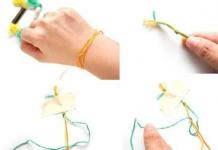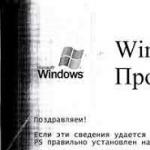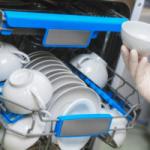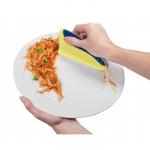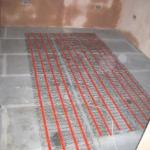When it comes to how to clean the photoconductor (phototube), then in 99% of cases, microfiber or any other lint-free cloth will come in handy.
You can also use compressed air bottles or special cleaners based on isopropyl alcohol, such as Xerox Cleaning Fluid.
CAREFULLY! In no case should one resort to the help of ammonia or ethanol solutions that can destroy the fragile photoconductive coating.
After cleaning, the drum unit must be put back into the laser cartridge.
If your cartridge has a waste ink bin, like on HP or Canon consumables, then lubricate the part with talcum powder. In its absence, it is enough to get by with used toner. Otherwise, the photoconductor may jam against the squeegee.
Why does the photoconductor get clogged?
In most cases, problems with the photoconductor arise due to the use of low-quality paper in the printing process, from which microparticles literally spill out, clogging the internal elements of the printer.
Also very often glue gets on the photoconductor. Especially if users resort to economical printing on the reverse sides of used paper.
When should the drum unit be replaced?
If you practice refilling cartridges, then the photoconductor will require special attention. Since this part is usually the first to fail.
You need to focus on the characteristic black stripes or spots along the edges of the print.
Recognized? Cleaning the drum unit won't help - it's time to replace it!

Figure 1: Image drum wear
Need to replace the photoconductor on a laser cartridge? Service center "MosToner" - round-the-clock free departure of the master within the Moscow Ring Road!
Optical photoconductor drum (OPC)- This is an integral component of a laser printer, which is important in the process of its operation. Partial or complete failure of the photoreceptor provokes the appearance of printing defects or contributes to a complete stop in the procedure for printing documents. Also, contamination of its surface can provoke a deterioration in the quality of prints. Therefore, this article is devoted to how the laser printer drum is cleaned in a cartridge at home.
When do you need to clean the drum unit?
The answer to this question is quite simple - when flaws appear on the printed pages.
Signs indicating that the phototube is dirty:
- The appearance of black symmetrical dots.
- Formation of dark bands.
- Documents have a gray background.
The surface of the OPC is covered with a sensitive photo layer that can be exposed to light. In these places, toner powder sticks to the drum axis, and then is transferred to the paper. Due to the limited operational capabilities of this part, the top layer wears out, which forces the owners of office equipment to restore the photodrum in specialized services. The life of the photosensitive drum can reach 40-80 thousand printed pages, but in printers for home and small offices this figure reaches 12-15 thousand pages.
Other factors also affect the operation of the photoconductor:
The quality of the paper used
Toner type (mechanical/chemical) and quality
Temperature and humidity in the room
Foreign objects (staples and other office debris) getting into the middle of the printer
Sometimes the cause of OPC clogging is the refilling of the printer with low-quality mechanical toner, carried out by the owner of the printing device. To solve this problem, you can order a cartridge refilling service from the after-sales service or try cleaning the drum unit yourself.
Cleaning the drum unit - step by step guide
Before proceeding to the description of the actions that will allow you to implement the drum cleaning procedure, we recommend that you familiarize yourself with the safety rules outlined below.
How to clean the drum unit
- Carry out work in a dark place protected from sunlight. Direct sunlight contributes to premature wear of the photo layer.
- Do not use flammable products or sprays.
- Do not touch the drum surface, magnetic roller, or other parts of the cartridge/printer with bare hands. Use rubber gloves.
- In case of direct contact with the toner, it must be shaken off and washed off with cold water. Toner ink is a complex chemical that can cause an allergic reaction or adversely affect human health.
How to clean the photo shaft?
To do this, you can use a dry, lint-free cloth or special wipes, which can be purchased at a specialized store. Also, effective results in cleaning the drum can be achieved using a vacuum cleaner, which is in the arsenal of every master who refills the printer or repairs the cartridge at home.
Cleaning steps
- Turn off the printer or MFP by unplugging the power plug from the outlet.
- Open the front cover of the print compartment where the required part is located.
- Remove the cartridge or drum cartridge from the slots and place it on a flat surface covered with newspapers or oilcloth.
- In order to get to the OPC installed in the drum cartridge, it is enough to remove the protective shutter. To access the drum, which is part of the cartridge, you must follow the instructions below:
- Detach the mounting clips located on the front and back sides.
- Remove all screws holding the side covers.
- Use a flat head screwdriver to pry up the sides and remove them.
- Carefully remove the PCR and gear assembly.
- Unscrew the 2 bolts securing the squeegee and remove it from the seats.
- Next, holding the edges of the axis, remove the photoconductor.
If, after following all the recommendations, the print quality has not improved, we recommend that you contact the office equipment service for help. It is possible that the phototube is worn out and needs to be replaced. Also, do not exclude the possibility of failure of other components of the cartridge, such as a magnetic roller or doctor blade. In this case, it is necessary to call the master at home so that he can diagnose the printing system and, if necessary, carry out a full repair of the cartridge.
If you are using an inkjet or laser printer, you may need to clean the cartridge. At home, devices are often used irregularly, but despite this, they need proper care. Timely cleaning contributes to obtaining high quality printouts allows you to extend the life of the equipment. Do-it-yourself cleaning can be carried out in hot and cold ways. In order to carry it out in time, you should know the first signs of problems associated with cartridges.
The fact that there is a need to inspect inkjet cartridges is evidenced by a number of print defects, the main ones being:
- on proof printouts, patterns contain jagged or fuzzy lines;
- during operation of the device, ink blots appear on the sheets;
- one or more colors are missing when printing a test pattern;
- When photographs and other color images are taken, horizontal streaks form on the paper.
Poor print quality
The considered defects are typical for different device models, for example, Epson, HP, Samsung, Canon. When the reboot does not help get rid of the unpleasant phenomenon, then you will need to clean the device cartridges. There are several reasons why you need to do this regularly:
- during downtime, it may happen that the paint in the nozzles has dried up, and it will need to be removed to remove blockages;
- dust from the air settles inside the printer, especially on the nodes covered with ink - the print head, cartridges.

For laser devices, cleaning is carried out when replacing the toner. At the same time, old paint and other contaminants are removed from the cartridge. The work is carried out with the help of napkins, cloth or brush without lint. It is important that the electrical contacts remain clean. Works are performed according to certain algorithms and do not require special skills.
Cleaning algorithm
Many jets are equipped with built-in automatic cleaning programs. To carry it out, proceed as follows:
- open the control panel;
- go to the settings of the printing equipment;
- there they select the required section - “Tools and cleaning the cartridge”;
- make a test printout of a blank sheet.


The operation can be repeated several times. Built-in tools allow you to get rid of minor contaminants.
If the function is missing, then you can download the program from a disk or the Internet and install it. Then, in the print settings, select the “Printer Maintenance” section, then you need to open the print settings, start cleaning. In this case, follow the instructions of the program. Most often, the procedure needs to be performed repeatedly.

When the software method did not help, then there are several other ways to get rid of the problem. For different models of inkjet technology, the algorithms are the same, only the way to access the cartridges is different. To do this, you may need a set of screwdrivers with different nozzles.
The scheme of work, regardless of the chosen cleaning method, is as follows:
- removing the cartridge;
- soaking;
- washing;
- drying;
- refueling;
- installation in the printer;
- control printout.
It is necessary to work carefully so as not to smear the surrounding objects, clothes with ink.
cold way
To implement the cold method, you will need to stock up on such available tools and materials:
- rubber gloves (medical);
- syringe;
- napkins (cloth) made of paper or cotton;
- clean water;
- pipette;
- special glass cleaner, which includes isopropyl alcohol or ethylene glycol.

An example of a suitable detergent is "Mr. Muscle", "Mr. Shine".
The whole process takes place in the following sequence:
- remove the cartridge from the printer;

- place it with nozzles up (on a specially laid fabric);
- a few drops of cleaning liquid are applied to them using a pipette;
- wait about 10 minutes;
- then wet the nozzles with a napkin, wipe them dry with a cotton cloth.

You may need a screwdriver to remove it, depending on the model of the device you are using.
The manipulations discussed above are not always enough. If the nozzles remain clogged, then the operation is continued:
- take a small container;
- fill it with cleaning liquid, pouring approximately a layer of 3 mm;
- immersed in the composition of the nozzle;

- keep them in liquid for 3 hours;
- take out and wipe dry.
After wiping the nozzles of the cartridge located in the working position with a cloth, it should stay ink trail, which is a characteristic result of complete cleaning. As a container for a detergent composition, an ordinary plastic lid from a can is suitable.

If the above actions did not lead to the desired result, then proceed as follows:
- prepare a silicone or rubber plug designed to close the air intake hole located on the top cover of the cartridge;
- pulling the piston, fill the syringe with the contents of the atmosphere;
- put a cut-out plug on the needle;
- insert it into the air intake;
- pressing on the syringe plunger, squeeze out air.

The dried dye is then squeezed out of the nozzles by the formed high blood pressure. After the cartridge to be cleaned is wiped, refilled and inserted into place inside the device. A printout of the template checks the quality of the cleaning.
hot method
If the cartridge is dry, then you can also use the hot method, when preliminary wiping with napkins did not give the desired result. In this case, the algorithm of actions is as follows:
- the bottom of a small container is covered with hot water;
- immerse nozzles in it;

- change the water without waiting for it to cool;
- the procedure is repeated until the staining stops;
- then, the detergent used is poured into the dishes used, mixed with water, based on a ratio of 1 to 1;

- the bottom of the cartridge is left for a couple of hours in solution;
- after the cartridges are washed using hot water for this, then dried;
- check the permeability of the ink by wiping the nozzles located in the position for work with a napkin;

- when the result is unsatisfactory, then all the manipulations are repeated again.
You can also purge with a syringe the way described above.
There are special liquids for removing dried ink on the market. They are divided even by types of cartridges, but the scheme of working with them is the same.

When cleaning the cartridge, no complicated manipulations are required, but the procedure itself is quite laborious. The easiest option during independent work is the use of special built-in programs. If none of the considered methods leads to the desired result, then it is necessary to remove contamination from the equipment units involved in printing. When this does not help, you should contact the service center specialists. They will accurately determine the cause of the problem, advise options for its elimination.
The main part of any laser cartridge is the photoconductor, which is a shiny roller that has a light blue or light green color, but other colors are also found - it depends on the manufacturer of the photocell. Its surface is covered with a special photo layer.
The service life of this part is quite long, but it is directly dependent on factors such as the quality of the paper used for printing, the type of toner, as well as the temperature and humidity of the room. Consequently, the photo shaft may fail ahead of time.
The human factor cannot be ruled out either - after all, various foreign objects and substances can get into the printer along with paper, which, in turn, can damage or contaminate the photoreceptor. Sometimes, when using low-quality toner, it can remain on the drum unit, as a result of which the print quality begins to limp a lot. Therefore, there are situations when you need to clean the laser printer drum.  In general, cleaning the drum of a laser printer with a competent and thorough approach is not so difficult. It is necessary to start solving this problem when, after printing documents, all kinds of defects remain on the sheets in the form of a gray background, black stripes and dots. In some cases, the toner is not compatible with the phototube. For this reason, to achieve really good print quality, you need to use the same brand of camera and toner. Otherwise, over time, you may even need to repair the photoconductor (but more often it’s just replacing it), which is unlikely to be done on your own.
In general, cleaning the drum of a laser printer with a competent and thorough approach is not so difficult. It is necessary to start solving this problem when, after printing documents, all kinds of defects remain on the sheets in the form of a gray background, black stripes and dots. In some cases, the toner is not compatible with the phototube. For this reason, to achieve really good print quality, you need to use the same brand of camera and toner. Otherwise, over time, you may even need to repair the photoconductor (but more often it’s just replacing it), which is unlikely to be done on your own.
Camera cleaning: steps
Models of laser-type printers, as a rule, provide for exclusively manual cleaning of the surface of the photoconductor, which is associated with the characteristics of laser printing. The whole procedure consists of several stages, the implementation of each of which must be taken with care. Before cleaning the cartridge drum, turn off the device by unplugging the power cord from the mains. Next, carefully open the front cover and remove the cartridge.

At the next stage, you need to move a special protective shutter, which is located on the cartridge and protects the photoconductor from damage. To clean the photoreceptor, it is not necessary to pull it out of the cartridge, it is enough to turn it in the direction of travel as the visible part of the photoshaft is cleaned. But there are times when it is not possible to clean the drum without removing it from the cartridge. Then you should pull it out very carefully, holding it exclusively by the ends. Please note that the primary charge roller is evenly pressed against its surface, with which you should be very careful not to damage it.
Be aware that if you turn the cartridge upside down with the drum removed, waste toner will spill out of the cartridge. Therefore, prepare a clean and smooth surface in advance. You can use sheets of paper or newspapers. Remember not to allow toner to come into contact with clothing or skin. If this still happened, be sure to rinse it off with cold water or shake it off, because the toner is a toxic substance (we recommend that you read the article about that).

To clean the drum unit, you need to arm yourself with a lint-free material, such as a tissue. With it, you need to wipe the surface of the drum until there is not a single particle of toner or greasy stain left on it. In no case do not use wet wipes, since after such a procedure the phototube will have to be thrown away.
It is also categorically not recommended to use all kinds of detergents, which contain a solvent, ammonia or alcohol. It is better to purchase a cleaning kit that is specifically designed for cartridges. In addition, cleaning of the phototube does not need to be carried out in bright light, otherwise the so-called light can be exposed. photosensitive layer.
After cleaning, it is necessary to carefully install the phototube in the cartridge and insert it into the printer, pressing until it clicks. At the end, it remains to check the print quality and, if it turns out to be satisfactory, then the procedure for cleaning the phototube was carried out properly.
If you still had to remove the drum to clean the drum, then before installing it, you need to powder it with a special lubricating powder - talc. If this is not done, then the photoshaft may rest against the squeegee and jam. At home, you can use the toner from this cartridge to lubricate the drum (working out is quite suitable). After installation, rotate the drum in the direction of its movement and clean any remaining talc or toner from the charge roller. Most Samsung, Xerox and Brother cartridges do not require lubrication of the phototube prior to installation. This procedure only needs to be done for waste hopper cartridges (HP and Canon).
Thus, the answer to the question of how to clean the laser printer drum is quite simple. Be extremely careful when cleaning the surface of the phototube, so as not to damage it. But if you do not have the proper skills or you are afraid to spoil something, then it is better to contact the nearest service center for help.
Did the printer stop printing well? The primary cause is a clogged cartridge. Let's see how to clean the printer cartridge. First you need to define the printers themselves. Printing documents, photographs and other graphics is done using printers. They are of several types:
- jet;
- laser;
- matrix.
They differ in printing methods, speed and scope.
Inkjet printers use dot-matrix heads for printing. A distinctive feature is the costly maintenance of the printer. Since inkjet printers have a fairly high consumption of ink, they are mainly used for home printing in small volumes. However, there are many types of inkjet printers. They are divided by type of ink and purpose. Here are some of them:
- office;
- interior - used for printing interior design;
- wide-format - used for printing advertising banners and other advertising inventory;
- marking - for drawing symbols on products, details;
- photo printers;
- souvenir - are used for printing on various kinds of souvenirs.
Laser printers
Without going into technological details, we can say that when printing, a photodrum is used that displays a dotted image. In terms of basic parameters, an inkjet printer is inferior to a laser printer.

A laser printer has high print quality on any paper, lower maintenance costs, and faster print speeds. Of the minuses, only a higher cost can be distinguished. But given that the maintenance of a laser printer is much cheaper, then this minus is compensated.
print cartridge
This special ink-filling device is used as a carrier for supplying ink to the printer's printing device. The print quality of the image directly depends on it.

If the cartridge is clogged, color reproduction and overall print quality will deteriorate, and some colors may not be printed.
The difference between inkjet and laser printer cartridges
The cartridge of a laser printer is filled with toner - a powder consisting of a coloring matter and wax or similar elements.

Under the action of high temperatures, the heated powder is applied to the surface of the paper. An inkjet printer uses liquid ink to print.
How to clean the cartridge
The main thing - remember that when cleaning the cartridge yourself from contamination, other components of the printer may become unusable. This will greatly increase the time and cost of restoring the cartridge in a service center. Cleaning a cartridge is not the easiest and safest procedure for both you and the printer. If possible, it is better to purchase a new cartridge.

How to clean a laser printer cartridge? The powder that is refilled in the printer cartridge is hazardous to health. It has been proven that getting into the respiratory tract, the toner can cause about a dozen different diseases. Therefore, when cleaning the cartridge yourself, do not open windows or doors to prevent the toner from being scattered. Use respiratory protective equipment. First of all, it is worth trying to use the software utility of the printer itself. It provides the ability to clean the printer cartridge. If this does not help, then there are several ways to clean it up.

Chemical soak. If you decide to do the cleaning yourself, then first remove the cartridge from the printer. Then take a container with a lid, pour 1 cm of glass cleaner into it and lower the cartridge into the liquid. Provided that it has not been used for a long time, dilute the liquid with water in a ratio of one to one. Close the container tightly with a lid and leave for 12 hours. The cleaning indicator will be a darkened liquid inside the container. After the cleaning period, remove the cartridge from the container and check. Attach the print part of the cartridge to the paper: if a clear, without blurring, black print (for a black cartridge) and blue, red, yellow prints (for a multi-colored cartridge) are printed, then the cartridge is clean.
Hot evaporation. Perhaps the easiest method to clean the cartridge. When using this method, special equipment and a long period of time are not required. Take out the cartridge. Boil water until steam appears. The cartridge must be held over hot steam for about 5 seconds. Then, as with chemical soaking, the cartridge is checked by the print side on the paper. If poor-quality prints are obtained on paper, the procedure must be repeated. Although the method is simple, it can have negative consequences. If the cartridge is overexposed to steam, then there is a high risk of parts peeling.

Washing with a special clip. The most effective cleaning method, but also the most expensive, since you need to purchase a special cleaning clip. First, the cartridge is filled with window cleaner and water in a one-to-one ratio. Then the mixture of water, glass cleaner and ink is sucked out of the cartridge with a special clip. After sucking out the remaining ink, you should check the print quality in the same way as in other methods.

How to clean the cartridge "Samsung ML-1520". It is necessary to unscrew 5 screws, unfasten the latch with a screwdriver or other flat object and disassemble the cartridge. Next, you need to unscrew the three screws on both sides and remove the fasteners. After - unscrew the two screws holding the photoconductor and remove it. Removed image drum should be immediately removed to a dark place. Next, you need to remove the magnetic shaft and clean the inside of the cartridge. Cleaning is over, now we assemble everything in the reverse order, refill with toner and make a test print.
How to clean an inkjet printer cartridge
How to clean HP inkjet cartridge and Canon inkjet cartridge. There are several ways to clean the inkjet cartridge. We will consider only the most effective of them.
Burial. The cartridge is removed from the printer and placed with the nozzle up. A small amount of cleaning agent should be applied to the nozzles. It can be a special cartridge cleaner or a regular window cleaner. In this position, the cartridge should stand for about 20 minutes. Then the surface of the cartridge is wiped with a dry cloth and checked during printing.

Air cleaning. For such cleaning, you will need a syringe with a needle. We draw air into the syringe, insert the needle into the filling hole, and then press the piston. The ink should come out of the cartridge nozzle under air pressure.
Maceration. The cartridge is removed from the printer and immersed in distilled water or a special liquid for cleaning the cartridge. It is put into the water in the same position as it was in the printer. It is necessary to leave the cartridge in the liquid for a period of a couple of hours to a couple of days.

How to clean a dried HP cartridge and a dried Canon cartridge. When drying a cartridge that has been left unused for a long time, special methods are used that are suitable only for a dried cartridge. They are mainly associated with the influence of high temperatures. Evaporation is one such method.

Evaporation. We prepare a shallow container and boiling water. Pour boiling water into a container by 1 cm. Without waiting for the water to cool, dip the cartridge into boiling water in the position in which it stands in the printer. We dip for 30 seconds, no more. We repeat the procedure 3 times. In this case, the cartridge must be refilled. Then we take the cartridge out of the liquid, dry it with napkins, immediately place it in the printer and make several test prints at the highest quality.
How to clean the printer drum
Another cause of poor print quality can be a clogged photoconductor. Power off the printer, unplug all cables, remove the cartridge, and remove the photoconductor from the printer. Place a bad print sample in front of the photoconductor to determine the exact location of the bad print. Having found a place, clean it with a dry cleaner: cotton, napkin, cloth. After cleaning, reassemble the cartridge and insert it into the printer.

Important! When cleaning the drum unit, do not touch it with fingers or sharp objects. The surface of the photoconductor is sensitive to damage.
How to refill a cartridge
After any cleaning of the cartridge, you need to refill the cartridge. The easiest solution would be to take the cartridge for refilling. If you want to refill the cartridge yourself, do not forget that this is not an easy procedure. By the way, the manufacturers of cartridges themselves do not produce funds for their refilling. Inkjet and laser cartridges are refilled in different ways.

How to refill an ink cartridge. First of all, get high-quality paint. Poor-quality ink entails drying of the cartridge and repeated cleaning procedure. Take an ordinary syringe and fill it with paint. There is a small hole on the surface of the cartridge, often covered with a sticker. Peel it off without breaking the integrity, and fill the contents of the syringe into the cartridge. Then stick the sticker in place - if you do not close the hole, the paint will simply pour out.

How to refill a laser printer cartridge. It is worth recalling that the powder used by laser printers is hazardous to health, and you should refill the laser printer cartridge in an unventilated area using respiratory protection.
- If you are not sure of your capabilities, then it is better to take the cartridge to a special service center.
- First of all, purchase a special powder used as a paint. Then cover the surface on which you will fill the cartridge with film or paper to prevent powder from getting on the table or carpet.
- There are models of cartridges with a special cover behind the side mount. Under this cover, you need to fill in the powder, and the filling is finished. In the absence of a cover, a complete disassembly of the cartridge is necessary.
Although in words cleaning and refilling the cartridge are simple procedures, their implementation requires a long time, and in some cases, special equipment. Therefore, the most correct and safest decision would be to take the cartridge to a service center for refilling. To prevent the ink inside the cartridge from drying out, frequent printing and timely refilling is necessary. Some cartridges may simply not be cleanable due to complete drying. In this case, it is much easier to purchase a new cartridge than to torture the old one.
